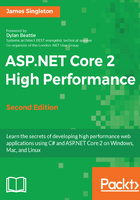
Looking at some alternative tools
For version control, Git is a very popular alternative to Team Foundation Version Control (TFVC). Git is integrated into many tools (including Visual Studio) and services, such as GitHub or GitLab. Mercurial (Hg) is also an option, although Git has gained the most developer mind share. Visual Studio Team Services (VSTS) and Team Foundation Server (TFS) both allow you to use either Git (including GitHub and Bitbucket integration) or legacy TFVC.
PostgreSQL is a fantastic open source relational database, and it works with many Object Relational Mappers (O/RMs), including Entity Framework (EF) and NHibernate. Now, it is also available on Azure along with MySQL. Dapper is a great tool that provides a high performance, alternative to EF and other bloated O/RMs. There are plenty of NoSQL options that are available too, for example, Redis and MongoDB.
Other code editors and Integrated Development Environments (IDEs) are available, such as Visual Studio Code by Microsoft, which also works on Apple OS X/macOS. ASP.NET Core 2 runs on Linux (on Mono and CoreCLR). Therefore, you don't need Windows (although Nano Server may be worth investigating).
RabbitMQ is a brilliant open source message queuing server that is written in Erlang (which WhatsApp also uses). This is far better than Microsoft Message Queuing (MSMQ), which comes with Windows. Hosted services are readily available, for example, CloudAMQP.
I've been a long time Mac user (since the PowerPC days), and I've run Linux servers well before this. It's positive to see OS X become popular and observe the rise of Linux on Android smartphones and cheap computers, such as the Raspberry Pi. You can run Windows 10 on a Raspberry Pi 2 or 3, but this is not a full operating system and is only meant to run Internet of Things (IoT) devices. Having used Windows professionally for a long time, developing and deploying with Mac and Linux and seeing what performance effects this brings is an interesting opportunity.
Although not open source (or always free), it is worth mentioning JetBrains products. TeamCity is a very good build and Continuous Integration (CI) server that has a free tier. ReSharper is an awesome plugin for Visual Studio, which will make you a better developer. There is also their new C# IDE called Rider that's based on ReSharper and IntelliJ (the platform that powers Android Studio and their other IDEs).
There is a product called Octopus Deploy, which is extremely useful for the continuous deployment of .NET and .NET Core applications, and it has a free tier. TFS also offers CI builds / CD releases, and there are cloud solutions, such as AppVeyor and VSTS.
Regarding cloud services, Amazon Web Services (AWS) is an obvious alternative to Azure. Even if AWS Windows support leaves something to be desired, this is less of a problem now that Core is available and runs on Linux. There are many other hosts available, and dedicated servers can often be cheaper for a steady load if you don't need the dynamic scaling of the cloud.
Much of this is beyond the scope of this book, but it would be wise to investigate some of these tools. The point is that there is always a choice about how to build a system from the huge range of components available, especially with the newer version of ASP.NET.